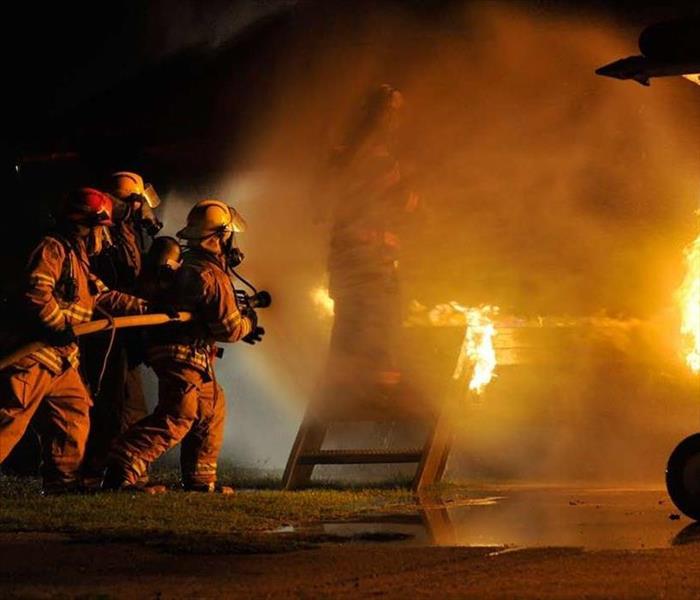How to Keep Safe During a House Fire
8/17/2017 (Permalink)
 In less than 30 seconds a small flame can turn into a major fire. It takes minutes for smoke to fill a house or for it to be engulfed in flames.
In less than 30 seconds a small flame can turn into a major fire. It takes minutes for smoke to fill a house or for it to be engulfed in flames.
You may not think you'll ever fall victim to a house fire, but it's better to be prepared and know what to do to avoid panicking if it happens to you. To increase your chances of survival, follow these steps:
Keeping safe in your house during a fire:
- React as soon as you hear your smoke alarm go off. If you hear your smoke detector or see fire, exit your home as safely as possible. Do not stop to grab your belongings. Your only concern should be to get out as quickly as possible.
- Safely exit through doors. If you see smoke under the door, do not open the door to escape. If you do not see smoke, put the back of your hand to the door to feel for heat. If it is cool, open slowly and pass through. If you see fire, close the door to protect yourself from the fire and search for another exit.
- Prevent yourself from smoke inhalation. Get low to the floor and crouch or crawl on your hands and knees to evade the toxic smoke, avoiding disorientation and unconsciousness. If you must walk through the smoke, cover your nose and mouth with a shirt or towel.
- Stop drop and roll if your clothes catch fire. Immediately stop what you're doing, drop flat on to the ground and roll around until you smother the fire. Cover your face with your hands as you're rolling to protect yourself.
- Ward off the smoke if you can't get out. If you cannot escape, you can always reclaim some measure of control and stay safe, even if you feel trapped. Close the door and cover all vents and cracks with a cloth or tape to keep the smoke out.
- Call for help from a second story window. If you are trapped in a second story room, do what you can to get yourself to an area where people will be able to hear or see you. Take a sheet- preferably white- and hang it out the window to signify you need help. Be sure to close the window to the fresh oxygen doesn't draw the fire towards you. Put a blanket or towel at the base of the door to prevent the smoke from coming underneath.
- Escape from a second story window if you can. If you have an escape ladder, toss it down the side of the house. If you must go out the window, look for a ledge you can get yourself onto and hang down from your hands, facing the side of the building. Let yourself fall to safety.
What to do once you exit your home:
- Do a head count. Make sure everyone is accounted for. If anybody is missing, only re-enter the building if it is safe to do so. Tell the first responders immediately on their arrival if you are afraid someone is missing.
- Call 911. Use your cellphone or call from a neighbor's house.
- Do an injury assessment. After making the call and the resources are coming, check yourself and your family for any injuries. If there are, do what you can to address them until the fire department arrives.
- Get away from the structure. Keep a safe distance between you and the fire.
Preventing future house fires:
- Form and practice your family's escape plan. Have a plan of escape in the event of a fire. Practice at least twice a year to get comfortable with the routine. Plan to find two ways to escape from each room. Practice escaping by crawling, being in the dark and having your eyes closed.
- Make sure your home is prepared. Check your smoke detectors are working and always have fresh batteries. Make sure your windows can easily be opened and that screens can be quickly removed. Everyone in your family should be able to open and close all windows. Buy reliable collapsible ladders in case of higher level escapes.
- Practice safe behaviors. Teach your children that fire is a tool, not a toy. Always be in the kitchen when you're cooking. SO not smoke in the house and make sure you put out your cigarettes entirely. DIspose of any electronics with frayed wires. Avoid lighting candles unless they're directly in your line of vision. Always check that the gas is turned off as well as any other wired electronics. Finally, try to use a lighter instead of matchsticks.
For more information as well as a community Q&A, click here for the source of the above information.






 24/7 Emergency Service
24/7 Emergency Service